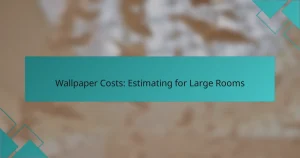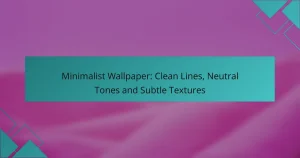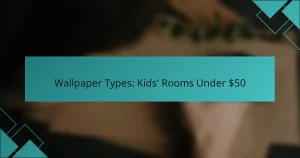Wallpapers can transform any space, offering a wide range of styles and materials to suit your personal taste and home decor. This guide will explore various wallpaper types, tips for selecting the perfect design, and highlight some of the top brands available in the market. Whether you're looking for a bold statement or a subtle backdrop, understanding your options will help you create an inviting atmosphere in your home.
Wallpaper Costs: Estimating for Large Rooms
Estimating wallpaper costs for large rooms involves understanding both material prices and installation expenses. In the US, average costs range from $1 to $5 per square foot, potentially leading to…
Minimalist Wallpaper: Clean Lines, Neutral Tones and Subtle Textures
Minimalist wallpaper is an ideal choice for modern homes, focusing on simplicity and elegance through clean lines, neutral tones, and subtle textures. This design approach creates a serene and uncluttered…
Wallpaper: Cost-Effective Refreshing Methods
Refreshing your space with wallpaper doesn’t have to break the bank. Cost-effective options such as peel-and-stick, traditional, and paintable wallpaper allow homeowners to enhance their interiors affordably. With installation costs…
Home Office Wallpaper: Productivity, Aesthetics and Comfort
Home office wallpaper plays a crucial role in enhancing both productivity and aesthetics in your workspace. By selecting the right colors, patterns, and textures, you can create an environment that…
Wallpaper: Budget-Friendly Options Under $30 per Roll
Transforming your space doesn’t have to be expensive, especially with budget-friendly wallpaper options available for under $30 per roll. These affordable choices come in a variety of styles and patterns,…
Kitchen Wallpaper: Heat Resistance, Durability and Design
When selecting kitchen wallpaper, it’s crucial to consider heat resistance and durability, as these factors ensure longevity in a high-temperature environment. Options like vinyl and fiberglass not only withstand moisture…
Vinyl vs. Paper Wallpaper: Which Is Better and When to Use
When choosing between vinyl and paper wallpaper, it’s essential to consider the specific needs of your space. Vinyl wallpaper is known for its durability and moisture resistance, making it ideal…
Bold Patterns: Small Space Solutions, Visual Impact and Style
Bold patterns can transform small spaces by adding visual interest and depth, making them feel more expansive and dynamic. When thoughtfully selected, patterns such as geometric designs, florals, or stripes…
Wallpaper Design Trends: Modern Aesthetics, Color Palettes and Textures
In 2023, wallpaper design trends are embracing modern aesthetics through the integration of natural elements, bold colors, and unique textures. Homeowners and designers are drawn to clean lines and cohesive…
Removing Old Wallpaper: Techniques to Protect Your Walls
Removing old wallpaper can be a challenging task, but with the right techniques and tools, you can protect your walls and achieve a clean finish. Methods such as peeling by…
What are the best wallpaper types for homes?
The best wallpaper types for homes include vinyl, non-woven, textured, fabric, and peel-and-stick options. Each type offers unique benefits and considerations, making it essential to choose based on your specific needs and preferences.
Vinyl wallpapers
Vinyl wallpapers are highly durable and moisture-resistant, making them ideal for areas like kitchens and bathrooms. They come in a variety of designs and textures, allowing for versatile aesthetics.
When selecting vinyl wallpaper, consider its thickness; thicker options tend to be more durable but may be harder to install. Look for products labeled as washable for easy maintenance.
Non-woven wallpapers
Non-woven wallpapers are made from a blend of natural and synthetic fibers, making them breathable and easy to apply. They can be removed without damaging the wall, which is a significant advantage for renters.
This type of wallpaper is often more forgiving during installation, as it allows for repositioning. However, they may not be as water-resistant as vinyl options, so consider the room's humidity levels.
Textured wallpapers
Textured wallpapers add depth and interest to walls, with options ranging from raised patterns to embossed designs. They can help hide imperfections on walls, making them a practical choice for older homes.
Keep in mind that textured wallpapers may require more effort to clean, as dirt can settle in the grooves. Choose a design that complements your overall decor style for the best effect.
Fabric wallpapers
Fabric wallpapers provide a luxurious feel and are available in various materials such as silk, linen, and cotton. They can significantly enhance the warmth and texture of a room.
However, fabric wallpapers can be more challenging to maintain and may require professional installation. Consider using them in low-traffic areas to preserve their appearance.
Peel-and-stick wallpapers
Peel-and-stick wallpapers offer an easy and temporary solution for wall decor. They are simple to apply and remove, making them perfect for those who like to change their decor frequently.
While they are convenient, ensure the surface is clean and smooth for the best adhesion. Some peel-and-stick options may not be as durable as traditional wallpapers, so check reviews before purchasing.
How to choose the right wallpaper for your room?
Choosing the right wallpaper for your room involves considering factors like size, lighting, and existing decor. These elements will help you create a cohesive and inviting atmosphere that enhances your space.
Consider room size
The size of your room significantly influences your wallpaper choice. For smaller spaces, lighter colors and subtle patterns can create an illusion of openness, while larger rooms can accommodate bolder designs without feeling cramped.
As a general guideline, if your room is under 100 square feet, opt for lighter shades. For rooms over 200 square feet, you can experiment with darker tones or intricate patterns.
Evaluate lighting conditions
Lighting plays a crucial role in how wallpaper colors and patterns appear. Rooms with ample natural light can handle darker or more vibrant wallpapers, while dimly lit areas benefit from lighter, reflective surfaces to brighten the space.
Consider testing wallpaper samples in different lighting conditions throughout the day. This will help you see how the colors change and ensure they complement your room's ambiance.
Match with existing decor
Your wallpaper should harmonize with your current decor to create a unified look. Take into account the color palette, furniture styles, and overall theme of the room when selecting wallpaper.
For a cohesive design, choose wallpapers that either complement or contrast effectively with your furnishings. If your decor is predominantly neutral, a bold wallpaper can serve as a striking focal point.
What are the top wallpaper brands in the UK?
The top wallpaper brands in the UK are known for their quality, design, and variety. Popular choices include Graham & Brown, Farrow & Ball, York Wallcoverings, and Ralph Lauren Home, each offering unique styles and materials to suit different tastes and budgets.
Graham & Brown
Graham & Brown is a leading wallpaper brand in the UK, celebrated for its innovative designs and high-quality materials. They offer a wide range of styles, from contemporary to classic, making it easy to find something that fits your decor.
When choosing Graham & Brown wallpapers, consider their eco-friendly options, which use sustainable materials and non-toxic inks. Prices typically range from £20 to £60 per roll, depending on the design and collection.
Farrow & Ball
Farrow & Ball is renowned for its rich colors and unique patterns, often inspired by historical designs. Their wallpapers are crafted using traditional techniques, ensuring a luxurious finish that enhances any space.
While Farrow & Ball products are on the higher end, with rolls costing around £90 to £120, the quality and aesthetic appeal justify the investment. Their wallpapers are also known for excellent durability and washability, making them suitable for various rooms.
York Wallcoverings
York Wallcoverings is one of the oldest wallpaper manufacturers in the UK, offering a diverse selection of designs, including traditional, modern, and textured options. Their products are known for their durability and ease of application.
York's wallpapers typically range from £15 to £50 per roll, making them a more affordable option without compromising on style. They also provide peel-and-stick options, which are great for renters or those looking for a temporary solution.
Ralph Lauren Home
Ralph Lauren Home brings a touch of luxury to wallpaper with its sophisticated designs that reflect classic American style. Their collections often feature elegant patterns and textures, ideal for creating a refined atmosphere.
Prices for Ralph Lauren wallpapers usually start at around £70 and can go up to £150 per roll. While they are more expensive, the distinctive designs and high-quality materials make them a worthwhile choice for upscale interiors.
How to install wallpaper effectively?
To install wallpaper effectively, start by preparing the wall surface and gathering the necessary tools. Proper preparation and technique are crucial for achieving a smooth, professional finish that lasts.
Prepare the wall surface
Preparing the wall surface is essential for successful wallpaper installation. Ensure the walls are clean, dry, and smooth; remove any old wallpaper, dirt, or grease. Fill in any holes or imperfections with spackle and sand the surface until it is even.
Consider priming the walls with a wallpaper primer, especially if they are porous or have been previously painted with a glossy finish. This helps the wallpaper adhere better and can prevent moisture damage.
Measure and cut wallpaper
Accurate measurement and cutting of wallpaper are critical steps in the installation process. Measure the height and width of the wall, and add a few extra inches to the length to allow for adjustments. Use a straightedge and a sharp utility knife for clean cuts.
When cutting multiple strips, ensure they are all the same length and pattern-matched if the wallpaper has a design. Lay the strips flat on a clean surface to avoid creasing.
Apply adhesive correctly
Applying adhesive correctly ensures that the wallpaper sticks properly and remains in place. Depending on the type of wallpaper, you may need to apply paste to the wall or the back of the wallpaper. Follow the manufacturer's instructions for the best results.
Use a roller or brush to apply the adhesive evenly, avoiding excess that could seep out during installation. Allow the adhesive to sit for the recommended time before hanging the wallpaper.
Use a smoothing tool
A smoothing tool is essential for eliminating air bubbles and ensuring a flat application. After positioning the wallpaper, use a smoothing tool or a clean cloth to gently press the wallpaper against the wall, starting from the center and working outward.
Be cautious not to apply too much pressure, as this can damage the wallpaper. If bubbles persist, use a pin to puncture them and smooth the area again. Regularly check for alignment and adjust as necessary during the process.
What are common wallpaper installation mistakes?
Common wallpaper installation mistakes can lead to unsatisfactory results and wasted materials. Key issues include inadequate wall preparation and incorrect measurements, both of which can significantly affect the final appearance of your wallpaper.
Ignoring wall preparation
Proper wall preparation is crucial for a successful wallpaper installation. This involves cleaning the walls, repairing any damage, and ensuring they are smooth and dry. Neglecting these steps can result in poor adhesion and visible imperfections.
Before applying wallpaper, consider using a primer designed for wallpaper. This can enhance adhesion and create a uniform surface, making it easier to achieve a professional finish. Always allow sufficient drying time for any repairs or primer before proceeding.
Incorrect measurements
Taking accurate measurements is essential to avoid running out of wallpaper or having excess material. Measure the height and width of each wall, accounting for any windows or doors. A common mistake is failing to measure around these obstacles, which can lead to miscalculations.
When measuring, use a level to ensure your lines are straight. It’s often helpful to add a few extra inches to your measurements to account for trimming and pattern matching. A good rule of thumb is to order 10-15% more wallpaper than calculated to cover mistakes and future repairs.






